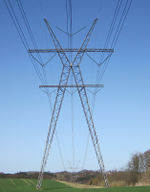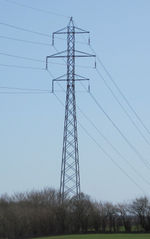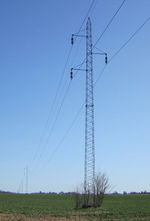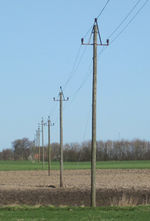Power networks/Denmark
For a map showing the currently mapped power lines in Denmark see Open Infrastructure Map.
See also Denmark/Da:Power_networks (in Danish)
Background
The Danish power grid is for historical and geographical reasons divided into two separate networks, a western network covering Jutland and Funen and an eastern network covering Sealand, Lolland and Falster. The western network is synchronous to the Central/West-European grid while the eastern network is coupled to the Scandinavian grid in Sweden and Norway. As these two networks are not synchronous they cannot be connected directly. In 2010 a high voltage DC connection across Great Belt coupling the two networks was completed enabling power transmission between east and west for the first time.
Overview of the voltage levels in use in Denmark:
| Voltage | Picture | Description |
|---|---|---|
| 400 kV | 
|
This voltage level uses mostly lattice towers but tubular steel towers are also found in a few places. Sometimes towers carry one or two 150/132 kV circuits as well. This voltage level is owned and operated by the Danish transmission system operator Energinet. |
| 150 kV (west) 132 kV (east) |

|
This voltage level uses lattice steel towers. Some power lines carry both a 150/132 kV and a 60/50 kV circuit. A significant part of the 150/132 kV grid has been undergrounded. This voltage level is also owned and operated by Energinet. |
| 60 kV (west) 50 kV (east) |

|
This voltage level uses mostly lattice steel towers carrying one or two circuits but wooden H-frame towers are also widely used. Significant parts of this network has been undergrounded. These power lines are owned and operated by various distribution companies. |
| 10 kV 15 kV 20 kV |

|
The medium voltage level can still be found as overhead lines in a few places and then mostly on wooden poles. In most areas this voltage level is now fully converted to underground cables. |
| 400 V | (no image) | This voltage level is rarely found above ground. |
Other voltages:
- 220 kV: Two 220 kV lines in Sønderjylland coupled to the German 220 kV grid. Also used for connection offshore wind farms to land.
- High voltage direct current (HVDC) connections: Konti-Skan 1, 2 between Vester Hassing (Aalborg) and Sweden. Skagerrak 1, 2 and 3 between Tjele (near Viborg) and Kristiansand (Norway). Kon-Tek between Bjæverskov on Sealand and Bentwisch in Germany (completely underground). Great Belt Power Link (Storebælt HVDC) between Fraugde, Funen and Herslev, Sealand (completely underground).
Tagging recommendations
- 50 - 400 kV power lines: power=line
- 0.4 - 20 kV power lines: power=minor_line
- Power cables (any voltage): power=cable
- Substations: power=substation
- Power generators: power=generator and generator:source=coal, gas, wind, ..
- Power plants (typically comprising multiple generators): power=plant
Tag pylons used for power=line as power=tower (also the wooden ones) and pylons for power=minor_line as power=pole (even if lattice type). For power lines tag the number of cables as cables=<number>. The number of cables is alway a multiple of 3 for AC lines (HVDC lines mostly have two cables). Don't count the one or more ground wires at the top of pylons, they don't carry any power but only serve as lightning protection. Tag the number of wires per cable as wires=<single,double,triple,quadruble> if it is known. Also, if known tag the voltage of the line as voltage=400000,150000,... Don't use kV or other units. You can also add other relevant information such as the operator of the line, name of power plants etc. You may consider tagging tower identification numbers as ref=<value> (this requires physical survey of towers)
For lines carrying multiple circuits of different voltages the following tagging scheme is suggested: Example for a power line carrying one 400 kV circuit and two 150 kV circuits. The 400 kV circuit has two wires per cable, the 150 kV circuits have just one wire per cable: voltage=400000;150000 + cables=3;6 + wires=double;single. Make sure you maintain the same order of values for all tags.